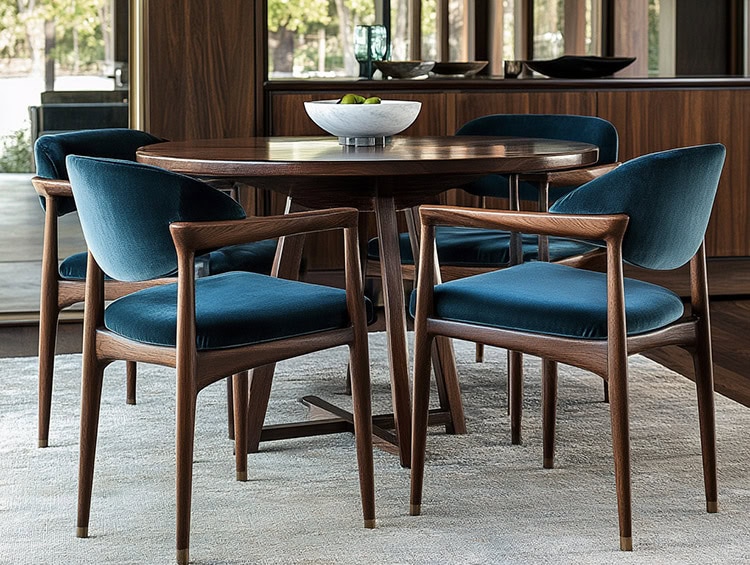The thought of mixing fabric patterns shouldn’t cause you an anxiety attack. Believe it or not, creating a beautiful blend of patterns within the home isn’t as hard as you might think. Here are some tips to make this an enjoyable process, rather than a stressful one.
1. Find Your Inspiration
It all begins with inspiration, so think of something you love and use that to fuel your pattern choice. Keep in mind that the main pattern you choose will anchor your color scheme and that picking something with a variety of colors will give you more options when it comes to picking complementary fabrics. This does not mean that your main fabric has to be used the most; it just means that everything else will build from it.
2. Consider Your Colors
Before you start picking patterns, it’s a good idea to narrow down your color choices. This alone is a great way to eliminate a lot of patterns that simply don’t include the colors you would like to see within the space.
3. Choose a Big Pattern
Now that you have your inspiration and have identified the key players of the color scheme, it’s time to start picking patterns. The first choice should be your big pattern. It’s the one that will be the jumping-off point for the others. Oftentimes, a big pattern will get lost on a small item. Therefore, reserve this particular pattern for something larger like an upholstered bench or ottoman, some drapery, or a duvet cover — items like these are better equipped to handle a big pattern.
While you can certainly use a big pattern on a piece of furniture like a sofa, in the end, you become limited with any changes you might want to incorporate in the future. It would essentially be easier to use it on something such as an accent chair. Even then, you would want to carefully consider if it’s a pattern you’ll be happy with for a long time.
4. Select a Solid (or Two)
Now’s the part where you can take a breath and enjoy the easier part of the process: picking out a solid or two that will work with the big pattern you’ve chosen. The nice thing about solids is that you can use more than one in the space and they’re much more forgiving to work with when used on larger pieces of furniture. It’s these solids that will be the perfect choices for sofas and loveseats.
5. Expand the Palette With Smaller Patterns
Once you have the main fabric and your solid(s), start choosing those smaller, complementary fabrics. As a general rule, sticking with three different patterns and a solid for a fourth is usually enough, but that doesn’t mean you can’t have more. If three patterns seem to be too many for you, however, then try two, incorporating a solid for the third, skipping the fourth altogether.
A good mix is to have a small-, medium-, and a large-scale pattern, with a common color connecting them. Don’t be afraid to branch out using a combination of florals, stripes, plaids, and geometric prints, as well as a variety of sheens and textures. For consistency, however, do your best to match the background shade no matter what the foreground pattern is. Even though you are mixing patterns, you want the look to flow, and matching the background color is the way to do it. If you still find yourself having a hard time with balance, apply the 60-30-10 rule: 60% of a dominant color, 30% of a secondary color, and 10% of an accent color.
For contrast, pull a dark shade out of one of your patterns and incorporate it somewhere throughout the room, either with a throw pillow, drapes, or accent pieces. Pulling one strong color will give your mix a punch.
5. Lay It Out Visually
While you can certainly try to compartmentalize all of your choices in your mind, that can be an incredibly daunting task. Our suggestion is a mood board, which is really just a fancy way of saying “a central place to view your ideas.” Traditionally, a mood or display board was actually created on a piece of foam board, but that’s not your only option these days. Now, you can create virtual mood boards on sites like Pinterest, or, you can simply collect your samples (paint chips, fabric samples, area rug pictures, furniture pictures, etc.) in a small box and then lay them out on the table for viewing.
Regardless of how you choose to do it, having a visual can be very helpful in the planning process in that it helps you see what works together and what doesn’t.
Bonus Tip: Give the Eye a Rest
To close the circle of your chosen palette, and to give the eyes a break, incorporate a neutral. Neutrals are a great way to ground everything in the room. It can be anything from a white throw pillow to a soft gray area rug that will bring the palette together.
Cutting Corners For All Your Fabric Choices
If all else fails, consider hiring a professional to help guide you along the way. Or, stop by our showroom to speak with an associate. We are always willing to offer insight so that you can create the perfect mix of the best patterns for your home’s interior. While you’re at it, be sure to top off your home’s interior fabrics with some of our many accessories, such as lighting, wall art, area rugs, and forever florals.
















